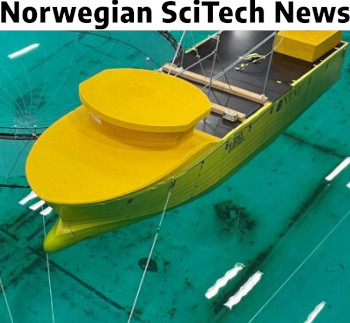|

Image: Norwegian SciTech News / FIS
Fish farming: this new vessel concept will assist open ocean aquaculture
 (NORWAY, 6/14/2023)
(NORWAY, 6/14/2023)
The following is an excerpt from an article published by euronews.green:
The aim is to extract the most efficient performance from all the various vessels utilised by the aquaculture sector at facilities exposed to rough seas and strong currents. Researchers have been looking into all aspects of this issue.

Photo: Norwegian SciTech News
Researchers have been studying how various kinds of vessels operate in the vicinity of facilities exposed to high waves and strong currents. They have been evaluating how weather conditions impact on operations and vessel logistics. Activities in the aquaculture sector represent an important part of day-to-day operations for many vessels. The studies have been carried out at the research centre ‘SFI Exposed’, which is being headed by SINTEF.
Out on the facilities, there are the so-called feed barges that operate close to the net pens. A net pen is a circular, floating ring from which a net is suspended that encloses the farmed fish.
Different vessels for different jobs
From the feed barge, where fish feeding operations are managed from a control room, work vessels make daily trips out to the pens. Fish farm workers have to make trips to inspect the facility and remove the bodies of fish that have died of disease or from other causes.

Source: Sea Machines
Facilities also require service vessels of different sizes, some equipped with cranes to assist in repair work, as well as lifting and unloading operations. Vessels are also needed when delousing procedures are carried out. So-called well boats are used for transporting living fish, whether as smolt for transfer into the pens, or for the removal to land of mature fish that are ready for slaughter. Well boats are also used in connection with delousing.
So-called processing vessels are used for the on-board slaughter of mature fish. This enables fish destined for processing facilities on land to be packed more densely than if they were transported alive in the tank of a well boat.
So-called silage vessels make regular visits to facilities to remove dead fish, and dedicated supply vessels deliver feed to the barges, which then distribute the feed out into the pens.
Faster vessels are also used to support diving operations and to transport personnel to and from the facilities.
Planning is worth its weight in gold
 “An assessment of all these vessels, their uses and their limitations, forms a key part of the knowledge base we need to develop proposals for new vessel concepts”, says Eivind Lona. “An assessment of all these vessels, their uses and their limitations, forms a key part of the knowledge base we need to develop proposals for new vessel concepts”, says Eivind Lona.
The development of new concepts represents just one aspect of research and innovation. Another is to improve the way we exploit what already exists.
At the research centre SFI Exposed, scientists have been studying vessel operations in the open ocean aquaculture sector with an emphasis on logistics optimisation and how weather conditions impact on a vessel fleet’s operational logistics.
Researcher Hans Tobias Slette has been using scale models to help simulate how a given fleet of vessels serves a group of aquaculture facilities under different weather conditions.
Model simulations are also used to assess how effectively a fleet of vessels can respond to events such as the mass death of a facility’s fish population.
“Vessels used in open ocean aquaculture carry large amounts of equipment. They are expensive and demand efficient utilisation”, emphasises Eivind Lona.
The precise planning of how a given fleet can serve given locations may be worth its weight in gold.
We need bigger vessels
For many years, a so-called ‘15-metre limit’ has governed vessel construction regulations and the qualifications requirements for skippers of vessels that are more than 15 metres in length. [Continues..]
Author: Guro Kulset Merakerås | Norwegian SciTech News | Read the full article by clicking the link here
[email protected]
www.seafood.media
Information of the company:
|
Address:
|
Strindveien 4
|
|
City:
|
Trondheim
|
|
State/ZIP:
|
(NO-7465)
|
|
Country:
|
Norway
|
|
Phone:
|
+47 73 59 30 00
|
|
Fax:
|
+47 73 59 33 50
|
|
E-Mail:
|
[email protected]
|
More about: 
|
|



